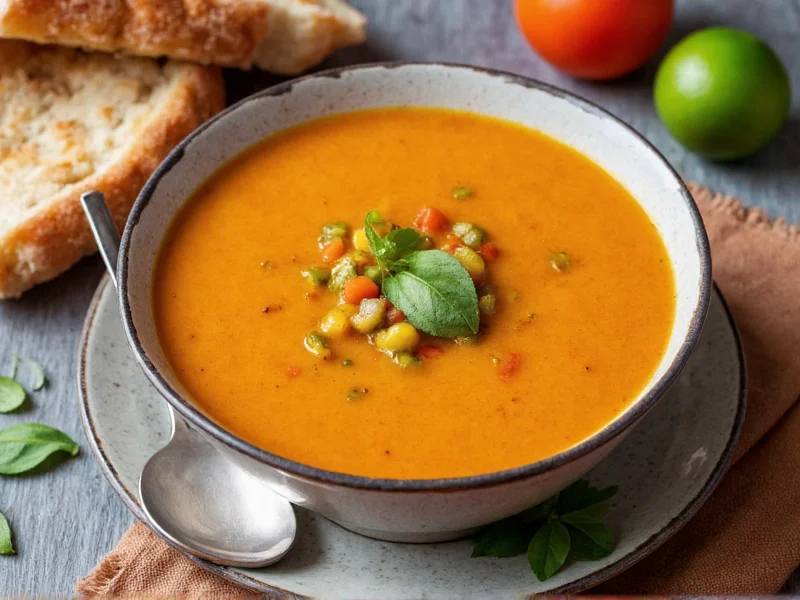Creating exceptional vegetable soup requires understanding how different ingredients interact and when to add them during cooking. Unlike many recipes that simply dump everything into a pot, professional chefs layer flavors by sautéing aromatics first, adding harder vegetables before softer ones, and finishing with fresh herbs. This technique preserves each vegetable's unique texture and flavor while building a complex broth that satisfies both taste and nutrition requirements.
Essential Ingredients for Perfect Vegetable Soup
The foundation of any great vegetable soup begins with what chefs call the "holy trinity" – onions, carrots, and celery. These aromatic vegetables create a flavor base that transforms simple broth into something extraordinary. When preparing these ingredients:
- Finely dice onions to ensure they melt into the broth
- Cut carrots into uniform 1/4-inch pieces for even cooking
- Use both celery stalks and leaves for maximum flavor
Fresh garlic added after the aromatics prevents burning while contributing depth. For umami richness without meat, incorporate tomato paste caramelized in the oil before adding liquids. This professional technique, often called "fond building," creates complex flavors that elevate easy vegetable soup recipes for beginners to restaurant quality.
Step-by-Step Vegetable Soup Preparation
Follow this method for consistently excellent results with healthy homemade vegetable soup:
- Heat 2 tablespoons olive oil in a heavy-bottomed pot over medium heat
- Add 1 diced onion, 2 diced carrots, and 2 diced celery stalks; cook 8-10 minutes until softened
- Stir in 3 minced garlic cloves and 2 tablespoons tomato paste; cook 2 minutes
- Pour in 6 cups vegetable broth and bring to gentle simmer
- Add harder vegetables (potatoes, turnips) and simmer 10 minutes
- Add medium vegetables (carrots, green beans) and simmer 8 minutes
- Add soft vegetables (zucchini, peas) and simmer 5-7 minutes
- Season with 1 teaspoon dried thyme, salt, and pepper to taste
- Finish with 2 tablespoons fresh parsley and lemon juice
| Vegetable Type | Cooking Time | Cut Size |
|---|---|---|
| Root vegetables (potatoes, turnips) | 15-20 minutes | 1/2 inch cubes |
| Medium vegetables (carrots, green beans) | 8-10 minutes | 1/4 inch slices |
| Soft vegetables (zucchini, tomatoes) | 5-7 minutes | 1/2 inch chunks |
| Leafy greens (spinach, kale) | 2-3 minutes | Roughly chopped |
Variations for Every Dietary Need
Adapt your quick vegetable soup recipe for weeknights to suit different preferences and occasions. For a creamy version without dairy, blend half the soup after cooking or add 1/2 cup coconut milk during the final simmer. To create a heartier meal, incorporate 1 cup cooked beans, lentils, or small pasta shapes during the last 5 minutes of cooking.
Seasonal variations make the most of vegetable soup recipes with seasonal produce. In spring, feature asparagus, peas, and fresh herbs. Summer versions shine with tomatoes, zucchini, and basil. Fall soups benefit from squash, sweet potatoes, and sage. Winter iterations feature root vegetables, cabbage, and warming spices like thyme and rosemary.
Pro Tips for Flavorful Results
Achieve restaurant-quality results with these professional techniques for simple vegetable soup recipes with pantry staples:
- Build flavor layers: Sauté aromatics in olive oil before adding liquid
- Control texture: Add vegetables in stages based on cooking time
- Enhance broth: Simmer with Parmesan rind or dried mushrooms
- Brighten flavors: Finish with lemon juice or vinegar
- Boost nutrition: Stir in leafy greens during the last few minutes
Avoid common mistakes like overcooking vegetables until mushy, adding salt too early (which draws out moisture), or using low-quality broth. Remember that the quality of your broth directly impacts the final product – when time allows, make your own vegetable stock from scraps.
Nutritional Benefits of Homemade Vegetable Soup
Regularly preparing nutritious vegetable soup recipes for cold weather delivers significant health advantages. A single serving typically contains 3-5 different vegetables, providing diverse vitamins, minerals, and fiber. The cooking process makes certain nutrients more bioavailable, particularly lycopene from tomatoes and beta-carotene from carrots.
Unlike canned alternatives, homemade versions contain no preservatives or excessive sodium. You control the salt content and can boost protein with additions like white beans or lentils. The high water content and fiber promote satiety, making vegetable soup an excellent choice for weight management while delivering essential nutrients.
Storage and Reheating Guidelines
Proper storage ensures your vegetable soup maintains quality and safety. Cool soup completely before transferring to airtight containers. Refrigerated soup stays fresh for 4-5 days, while frozen portions maintain quality for 4-6 months. When reheating:
- Thaw frozen soup overnight in the refrigerator
- Reheat on stove over medium-low heat, stirring occasionally
- Add splashes of water or broth if soup has thickened
- Bring to 165°F (74°C) before serving
For meal prep convenience, portion soup into individual containers. This approach supports vegetable soup recipes with step-by-step instructions for busy weeknights when quick, healthy meals are essential.











 浙公网安备
33010002000092号
浙公网安备
33010002000092号 浙B2-20120091-4
浙B2-20120091-4